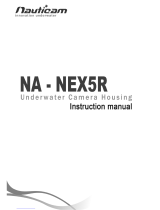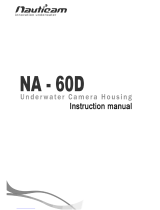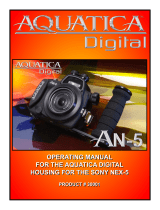Page is loading ...

Product Registration
Please register your product within 15 days of purchase. Our product
registration database is the quickest way for us to contact you in the
event of a product update.
To register, send a photo of the above registration label to us via
[email protected] along with your name, address, and phone
number.
Underwater TTL Housing for Canon PowerShot
G3X
Product # 6146.03

2
Introduction
Thank you for your purchase of Ikelite products.
Our primary focus is to provide quality, professional grade products
for use in and under water. Our products are designed, manufactured,
and distributed from our sole facility in Indianapolis, USA where we
started in 1962.
We are available if you have any questions or want photo advice.
Send us an email 24 hours a day to [email protected]. We strive to
reply within 1 business day.
An electronic version of this instruction manual is available for
download via the product page on our website:
https://www.ikelite.com
In the Box
• Housing
• Main o-ring # 0110 (installed)
• Port cover # 0200 (installed)
• Waterproof bulkhead cap # 9104.7 (installed)
• .050” hex key # 0945.11
• 1/16” hex key # 0945.16
• 1/8” hex key # 0945.18
• Silicone lubricant 1cc tube

3
Important Notices
» A bulkhead cap or sync cord must be attached to the housing
bulkhead for waterproof operation. Never submerge the
housing in water without either a sync cord or bulkhead cap
attached.
» Do not pull the shutter trigger without a camera installed. You
may accidentally detach or damage the control spring.
» Never leave a housing in a rinse tank, even if it is the only
system in the tank. Accidental damage may occur when the
user walks away from a housing while it is in the rinse tank.
» Do not use alcohol, cleaning agents, spray lubricants, Rain-X,
or other solvents on the housing or lens port. Use of an
incompatible chemical compound can damage the plastic and
o-rings, and may result in leaking.

4
Contents
Product Registration 1
Introduction 2
In the Box 2
Important Notices 3
Getting to Know Your Housing 6
Tray Mounts 8
Accessory Port 8
Lanyard Mount 8
Setting Up Your Camera 9
Pre-Installation Checklist 9
Camera Settings 9
Exposure Settings 9
Setting Up Your Housing 10
Opening the Housing 10
Installing the Camera 10
Attaching the Hotshoe 12
Closing the Housing 12
Setting Up An External Strobe 13
About Electrical Sync Cords 13
TTL Strobe Compatibility 14
Attaching an Electrical Sync Cord 14
About Fiber Optic Cords 16
Attaching a Fiber Optic Cord 16
Getting in the Water 17
Final Check 17
Entering the Water 18
Shooting Underwater 18
Learning about Underwater Photography 19
Maintaining Your Housing 19

5
Post-Dive 19
Lens Port 20
Storage 20
Servicing Recommendations 21
Lubricating Controls 21
Lubricating Push Buttons 22
Lubricating Control Shafts 23
Troubleshooting 25
Spare Parts 27
Limited Warranty 27
Service and Repairs 28
Contact Us 28

6
Getting to Know Your Housing
Shutter
Bulkhead
with cap
Lid snap
Tray mounts
Rubber
grip
Fiber optic
ports
Mode dial
Front dial
Lens port

7
S
MENU
DISP
O-ring
S
MENU
DISP
Left / Macro
AF frame
selector
Display
Control dial
Lanyard
mount
Playback
Down / Drive
mode
INFO / Down
Shortcut
Right / Flash
Power
Q.Set / Set
AF/MF/AEL
Control dial
Up / ISO
Menu
Erase

8
Tray Mounts
This housing features two 1/4-20 threaded tray mounts on the bottom
of the housing. The spacing between the tray mounts is 3” (76.2 mm).
Optional tray with handles and mounting hardware are sold separately.
It is recommended to detach and thoroughly rinse the tray mounts,
tray, and mounting hardware, with fresh water routinely during
continuous use and prior to storage.
Accessory Port
This housing features one spare accessory port which may be used
for the attachment of optional accessories. This port accepts ttings
designed for a 1/2” through or 1/2-20 threaded hole.
The optional Vaccum Kit # 47012 may be installed in this location. A
hand pump with gauge allows you to draw a vacuum on the house
to simulate water pressure and check for leaks prior to entering the
water.
Visit ikelite.com for an updated list of compatible products.
» Do not remove or loosen the accessory port plug unless you
are installing a compatible accessory.
Lanyard Mount
The included lanyard is a break-away safety lanyard. The lanyard is
designed to break if stress is placed on it. This is important so that
the user can break free if the equipment is caught on something
underwater.
The lanyard is not designed to support the weight of the housing and
should not be used as a carrying strap. Carrying the housing by the
lanyard may result in damage to the lanyard and/or housing.
A different lanyard with a thin cord may be attached to the housing
using the lanyard mount on the side of the housing back.

9
Setting Up Your Camera
Pre-Installation Checklist
1. Insert a fully charged camera battery.
2. Insert a properly formatted memory card.
3. Remove any attached lanyard or neck strap.
4. Raise the camera’s built-in ash if using an external strobe
connected by ber optic cord. Leave the built-in ash closed if
using an external strobe connected by electrical sync cord.
Camera Settings
• Set Touch operation to “Disable.”
• Set AF-assist beam to “Off.”
• Set Flash mode to “Auto” when using an external strobe.
• Set Red-eye lamp to “Off” when using an external strobe.
Exposure Settings
Refer to the Cheat Sheets in the Photo School section of our website
for recommendations on exposure settings for a wide variety of
shooting situations:
https://www.ikelite.com/blogs/cheat-sheets

10
Setting Up Your Housing
Opening the Housing
1. Push the lid snap lock forward and lift the curved end away from
the housing.
Lock
2. Lid snaps are designed to provide enough force to compress the
o-ring for a proper seal. Keep rm pressure against the lid snap
while lifting it away.
3. Repeat with opposite lid snap.
4. Remove the housing back.
Installing the Camera
1. Remove any lanyard or neck strap which may be attached to the
camera.
2. Remove the camera mount plate from the housing.

11
3. Line the mount screw up with the camera’s tripod socket. Use a at
screwdriver to tighten the mount plate to the camera.
4. Pull out on the housing control knobs to move the controls out of
the way.
5. If using an external strobe connected by ber optic cord, raise
the camera’s built-in ash. If using an external strobe connected
by electrical sync cord, leave the built-in ash closed. The ash
cannot be raised or lowered once the housing is closed.
6. Insert the mount plate into the slot on the inside bottom of the
housing. Push the camera all of the way forward until it stops.
7. Push housing control knobs in and check orientation with the
camera.
» The camera may be attached to a tripod using the 1/4-20
threaded mounting hole on the bottom of the mount plate.
» The camera’s built-in ash must be raised prior to closing the
housing.
» The camera’s built-in ash cannot be raised or closed
underwater.

12
Attaching the Hotshoe
1. If using a strobe connected by electrical sync cord, orient the
hotshoe with the arrow on top pointing towards the front of the
camera.
2. Slide the housing hotshoe into camera’s hotshoe mount until it
stops.
» The hotshoe must be all the way forward in the camera mount
for proper ash operation.
» Do not attach the hotshoe if using a strobe connected by ber
optic cord. Connecting the hotshoe will disable the camera’s
built-in ash.
Closing the Housing
1. Make sure the o-ring is clean and in its proper location on the back
of the housing. The rear housing o-ring does not require lubricant
to make a seal.
2. Place the back onto the housing front.
3. Make sure no controls or wires are interfering with the o-ring or the
back of the housing.
Housing
hotshoe
Camera
hotshoe
mount

13
4. Place each lid snap into the corresponding hook on the housing
back.
5. Push the lid snaps towards the housing until they are at against
the housing and the lock has engaged. Close both lid snaps at the
same time.
6. Check the o-ring seal. The o-ring should form a uniform, solid line
visible through the back of the housing.
7. Check control functions.
Setting Up An External Strobe
We recommend attaching an external strobe for the optimal color and
clarity in a wide variety of photographic situations, including daylight
photography.
This housing provides a direct electrical connection to the camera’s
external ash hotshoe via a manual ash hotshoe. An external strobe
may be triggered via electrical sync cord.
This housing also provides ber optic ports for optical triggering of up
to two strobes.
About Electrical Sync Cords
Connecting a strobe via electrical sync cord provides faster strobe
recycle times as compared to a ber optic connection, and prolongs
camera battery life.
» To connect two strobes to the camera, you must use a dual
sync cord.
» A second slave strobe may be triggered optically off of a
primary strobe connected by sync cord.

14
TTL Strobe Compatibility
When compatible Ikelite DS strobe(s) are attached by electrical sync
cord, the TTL circuitry built into the housing allows the camera to
communicate directly with the attached strobe(s). The camera triggers
the strobe(s) and adjusts the strobe(s) power automatically for perfect
exposure.
The following strobes are TTL compatible with this housing:
• Ikelite DS50 above serial # 70000
• Ikelite DS51
• Ikelite DS125 above serial # 5000
• Ikelite DS160, DS161
• Ikelite DS200 above serial # 7163
Flash exposure compensation may be added or subtracted using the
camera’s menu settings. Due to the camera’s pre-ash sequence,
manual full power setting cannot be used when a DS strobe is
attached by ber optic sync cord.
Strobes from SEA&SEA, INON, and other manufacturers may be
attached by electrical sync cord for faster shooting and extended
battery life compared to ber optic triggering. These strobes are not
capable of powering the TTL circuitry built into this housing. Non-
Ikelite strobes must be used in manual power modes when connected
by electrical sync cord.
Attaching an Electrical Sync Cord
1. Remove connector protectors and bulkhead caps from each
connection.

15
2. Apply a very thin, even layer of lubricant on all threads, sealing
surfaces, and the exposed portion of the plug o-ring. Do not allow
lubricant to get into the pins and receptacles of the plug or
bulkheads.
Bulkhead
Bulkhead
cap
Retaining
ring
3. Align plug and insert into the housing bulkhead. Each male pin
mates with a female receptacle. Failing to line up the contacts
properly before tightening may result in damage to the converter
plug and/or housing bulkhead.
4. Hand-tighten the retaining ring.
5. Attach the other end of the sync cord to the bulkhead on your
strobe.
6. Turn on the strobe(s).
7. Turn on the camera. Take a test photo to ensure that your strobe(s)
are functioning properly.
» A bulkhead cap or sync cord must be attached to the housing
for waterproof operation. Never submerge the housing without
either a sync cord or waterproof bulkhead cap attached.
8.

16
About Fiber Optic Cords
Connecting a strobe via ber optic cord requires the camera’s built-in
ash to re for every photo. Rapid ring will be limited to the recycle
time of the camera’s built-in ash or the recycle time of the strobe,
whichever is slower.
The following ber optic cords are compatible with this housing:
• Ikelite Fiber Optic Cord # 4501
• INON Optical D Cable “Non-wireless type” L-Connector
• SEA&SEA Fiber Optic Cable (L-type) # 50107
• SEA&SEA Fiber Optic Cable II # 50128
• Olympus UW Fiber Optic Cable # PTCB-E02
• Nauticam Optical Fiber Cable # 26211 Nauticam to INON
• Nauticam Optical Fiber Cable # 26212 Nauticam to SEA&SEA
» To connect two strobes to the housing, you must use two ber
optic cords.
Attaching a Fiber Optic Cord
1. Check the end of the ber optic cord to ensure that it is clean and
smooth.
2. Check that the ber optic cord o-ring is in place. This o-ring does
not provide waterproong, but it does keep the ber optic cord in
place.

17
3. Attach one end of the ber optic cord to one of the ber optic ports
on the housing. The connector is a press-t into the port.
4. Attach the other end of the ber optic cord to a compatible strobe.
5. Set the strobe according to the manufacturer recommendations.
6. Turn on the strobe.
7. Turn on the camera. Take a test photo to ensure that your strobe(s)
are functioning properly.
» The camera’s built-in ash must be raised prior to closing the
housing.
» The camera’s built-in ash cannot be raised or closed
underwater.
Getting in the Water
Final Check
1. Re-check the rear o-ring seal. The seal should form an even, solid
line visible through the back of the housing.
2. Turn on the camera and check all control functions.
3. Make sure the camera can take a photo.
4. Check camera battery level and available storage space on your
memory card.

18
5. Draw a vacuum on the housing to check for leaks using the
optional vacuum kit, if using (sold separately).
6. Submerge the housing in a fresh water tank dedicated to
underwater photography equipment. Visually conrm that there are
no signs of water intrusion. One sign of water intrusion is a steady
stream of bubbles coming from one of the housing’s seals.
Entering the Water
1. Before entering the water, turn the camera on and operate each
of the housing controls to get a feel for using the camera in the
housing.
2. We recommend entering the water without your housing to ensure
you are comfortable and your life-saving equipment is in working
order. Once you are stable, have someone pass your camera
housing to you.
3. Submerge the housing at the surface of the water and visually
conrm that there are no signs of water intrusion. Look for water
droplets or fogging inside of the housing, or a steady stream of
bubbles coming from one of the housing seals.
4. Use your hand to gently ush away any small bubbles that may be
on the face of the lens port. Bubbles will produce soft focus spots
in your photo or video.
» If water appears to be entering the housing, point the lens port
downward and return the housing to the surface immediately.
Please observe all necessary safety precautions. NEVER
ascend faster than accepted safety limits.
Shooting Underwater
• Get as close as possible to your subject. For the best results, only
photograph subjects that are less than 6’ (1.8m) away.
• Be careful not to stir up sand or silt.

19
• Photograph subjects straight on or at a slight upward angle.
• If you err in exposure, it is better to have the image slightly
underexposed rather than overexposed. An overexposed image
is missing color information which cannot be adjusted in a photo
processing program. A slightly underexposed image has color
information that can be adjusted.
» It is important to respect all living creatures underwater,
including people, marine life, and coral. Get as close as you
can to your subjects when taking a photograph, but never
touch or disturb the marine life.
Learning about Underwater Photography
Visit the Photo School section of ikelite.com for a wide range of
information on shooting underwater including:
• Product Tutorials and Videos
• Cheat Sheets with exposure setting recommendations for a wide
variety of situations
• Advanced Techniques with in-depth articles on different shooting
techniques
• Frequently Asked Questions
• Photo Galleries showing examples of real results underwater
• Feature Articles and more!
Maintaining Your Housing
Post-Dive
1. Rinse the housing in fresh water. Rotate the housing controls and
press each button several times while submerged in fresh water to
ush out any salt or debris to ensure smooth operation on future
dives.

20
2. NEVER leave your housing in a fresh water rinse tank, even if it is
the only system in the tank. Collisions with another person’s gear
can cause scratches or damage to your equipment. Accidental
damage occurs most often in the rinse tank.
3. Rinse off any residual residue from the rinse tank with clean,
running fresh water.
4. Stow the housing in a shaded place where it is protected from
impact and overheating. If no shade is available, cover the housing
with a light colored towel or cloth.
5. Check the memory card capacity and battery life of your camera
and strobe(s). Recharge as necessary.
6. Always re-check the o-ring seal after opening the housing.
7. Detach the cord plug or bulkhead cap and lubricate the threads,
o-ring(s) and sealing surface(s) every 2-3 days during continuous
use.
Lens Port
Treat the surface of the lens port like a camera lens. After use, rinse
and gently dry the outside lens port to avoid water spotting. Use only a
microber lens cleaning cloth to avoid scratches. To clean, use a mild
soap solution.
» Do not rinse the inside of the lens port.
» Do not use alcohol, cleaning agents, spray lubricants, Rain-X,
or other solvents on the housing or lens port. Use of an
incompatible chemical compound can damage the plastic and
o-rings, and may result in leaking.
Storage
1. Clean the housing and controls thoroughly prior to storage.
/






